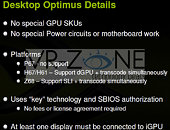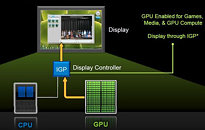- Joined
- Oct 9, 2007
- Messages
- 47,449 (7.50/day)
- Location
- Hyderabad, India
| System Name | RBMK-1000 |
|---|---|
| Processor | AMD Ryzen 7 5700G |
| Motherboard | ASUS ROG Strix B450-E Gaming |
| Cooling | DeepCool Gammax L240 V2 |
| Memory | 2x 8GB G.Skill Sniper X |
| Video Card(s) | Palit GeForce RTX 2080 SUPER GameRock |
| Storage | Western Digital Black NVMe 512GB |
| Display(s) | BenQ 1440p 60 Hz 27-inch |
| Case | Corsair Carbide 100R |
| Audio Device(s) | ASUS SupremeFX S1220A |
| Power Supply | Cooler Master MWE Gold 650W |
| Mouse | ASUS ROG Strix Impact |
| Keyboard | Gamdias Hermes E2 |
| Software | Windows 11 Pro |
While NVIDIA and AMD are just about done with their consumer GPU launches for the current generation, NVIDIA has something in store for Computex, 2011, one of the year's biggest technology tradeshows. The GPU giant will announce NVIDIA Optimus technology's desktop avatar, for now known as "Synergy". The technology allows on-the-fly switching between a computer's integrated graphics and discrete NVIDIA GeForce graphics processor, giving you access to the feature-set of both, and allowing a fair amount of power-saving in the process.
NVIDIA's new technology is designed specifically for Intel's Sandy Bridge desktop platform, particularly motherboards with Intel H61, H67, and Z68 chipsets (you can't access IGP with P6x). Unlike SLI, motherboard vendors needn't shell out a license fee or sign an agreement to implement the technology. A supportive motherboard will have authorization code implanted into SBIOS, much like SLI. In practice, the technology will allow users to switch to a GeForce GPU (or a pair of GPUs on Z68) when gaming or in 3D-heavy applications; while falling back to the power-efficient IGP or even making use of Intel's QuickSync technology, when not gaming.


The display is connected to the IGP (motherboard), when the discrete GPUs are active, the IGP functionally turns into a display controller (like NVIO2) while the discrete GeForce GPUs render ultra-complex graphics and PhysX. When the discrete GPUs are inactive, the IGP is in-charge of all graphics rendering (including Windows Aero UI). The user can manually switch on-the-fly, or set up profiles to switch when a particular application/game is launched.
View at TechPowerUp Main Site
NVIDIA's new technology is designed specifically for Intel's Sandy Bridge desktop platform, particularly motherboards with Intel H61, H67, and Z68 chipsets (you can't access IGP with P6x). Unlike SLI, motherboard vendors needn't shell out a license fee or sign an agreement to implement the technology. A supportive motherboard will have authorization code implanted into SBIOS, much like SLI. In practice, the technology will allow users to switch to a GeForce GPU (or a pair of GPUs on Z68) when gaming or in 3D-heavy applications; while falling back to the power-efficient IGP or even making use of Intel's QuickSync technology, when not gaming.


The display is connected to the IGP (motherboard), when the discrete GPUs are active, the IGP functionally turns into a display controller (like NVIO2) while the discrete GeForce GPUs render ultra-complex graphics and PhysX. When the discrete GPUs are inactive, the IGP is in-charge of all graphics rendering (including Windows Aero UI). The user can manually switch on-the-fly, or set up profiles to switch when a particular application/game is launched.
View at TechPowerUp Main Site
Last edited by a moderator:



 . Also I hope that nVidia allows the users to select the programs for which the dGpu is enabled.
. Also I hope that nVidia allows the users to select the programs for which the dGpu is enabled.